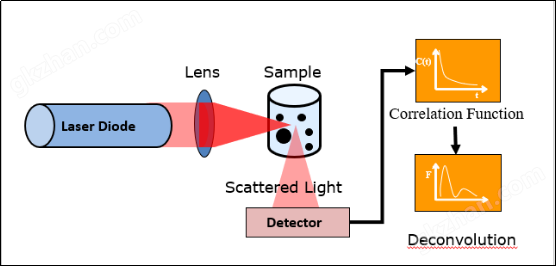Dynamic Light Scattering
The Nicomp 380 Submicron Particle Size Analyzer uses the principle of Dynamic Light Scattering (DLS) to obtain the partcile size distribution of colloidal systems whose sizes range from 0.5 nanomters to 6 microns. DLS works by illuminating a group of particles in suspension with a focused laser beam which gives rise to many scattered light waves. These waves interfere with each other and produce a net scattered intensity that fluctuates as a function of time at some distant detector. Diffusion, or Brownian motion, of the particles causes random variations in the phases of the individual waves, resulting in a fluctuating light intensity. The particle size distribution can be obtained by analyzing the time behavior of these fluctuations using an autocorrelator. The autocorrelation function for a single uniform size distribution is a decaying exponential function where particle diffusivity is easily obtained from the decay time. Finally the particle radius can easily be calculated using the Stokes-Einstein relationship. In general most samples are not uniform instead they are quite often polydisperse, having a range of particle sizes. The autocorrelation function then consists of a combination of decaying exponential functions, each having a different decay time and the analysis of the autocorrelation function is no longer quite simple. The instrument using varying deconvolution algorithms must invert the raw data in order to arrive at the best estimate of the true particle size distribution. The Nicomp excels at characterizing these difficult particle size distributions by utilizing a group of unique deconvolution algorithms ranging from a simple Gaussian approximation to a proprietary high resolution multi-modal deconvolution analyses called the “Nicomp Distribution". Some of the unique features found on Gaussian analysis mode is a baseline adjust parameter which provides aggregate compensation that excedes the sensitivity found on most other instruments which employ a dust or dirt factor. The Gaussian analysis mode also allows for the user to specify a solid or vesicle weighting mode for analysing thin walled colloidal systems like liposomes. The Nicomp Analysis Mode is a proprietary high-resolution deconvolution algorithm that was first introduced over 25 years ago. It has historically proven its ability to accurately analyze even the most difficult closely spaced bimodals (e.g. 2:1 apart) and even certain trimodal distributions. This is extremely useful in finding the native peak of the aggregate distribution. The standard Nicomp 380 is equipped with a 12 mW laser diode and PMT detector with an optical fiber set to 90°. Sample is introduced with drop-in cells.The 380 is the only Dynamic Light Scattering Instrument designed using a modular approach. Its capabilities may be enhanced by adding one or more modules: Autodilution This patented module eliminates the need for manual dilution of concentrated sample. Autodilution makes particle size analysis quick and easy, with no training required. Results are highly reproducible. 380/HPLD High Power Laser Diodes PSS offers an array of high power laser diodes to meet the needs of our most demanding applications. Higher power lasers are needed to extend the lower limit of our instrument by providing adequate scattering from small particles. They are also useful when measuring large particles such as dextrans, which yield insufficient scattering intensity because of index of refraction properties. The result is a more versatile instrument, ideal for sizing microemulsions, surfactant micelles, proteins and other macromolecules. It can even estimate the extent of aggregration of biopolymers after reconstitution, without chromatographic separation. Avalanche Photo Diode (APD) Detector The Nicomp 380 can be equipped with various high-powered lasers as well as a high-gain Avalanche Photo Diode Detector (APD which provides approximately seven times the gain of a conventional photomultiplier tube. The APD is used to increase signal-to-noise and sensitivity in systems that do not scatter light well. Proteins, micelles, other macro-molecular-based systems, and nanoparticles are often dilute (1 mg/ml or less) and are made of atoms that do not scatter light well. The Avalanche Photo Diode coupled with a nominally higher powered laser diode module offers a low cost solution for accurately analyzing nanoparticles in a short period of time. 380/MA Multi-angle Goniometer Particles larger than 100 nm do not scatter light isotropically in all directions. It is possible to make DLS measurements more sensitive to certain sized particles by changing the angle of detection. The Nicomp 380 can be equipped with a mini-goniometer that moves the optical fiber between 12° and 175° by 0.9° increments. Zeta Potential The Nicomp 380/ZLS is designed to measure the electrophoretic mobility and zeta potential of charged particles in liquid suspension. The main reason to measure zeta potential is to predict colloidal stability. The interactions between particles play an important role in colloidal stability. The use of zeta potential measurements to predict stability is an attempt to quantify these interactions. The zeta potential is a measure of the repulsive forces between particles. Since most aqueous colloidal systems are stabilized by electrostatic repulsion, the larger the repulsive forces between particles, the less likely they will be to come close together and form aggregates. Thus the more stable a colloid will be. The Nicomp 380/ZLS combines the techniques of Dynamic Light Scattering (DLS) and Electrophoretic Light Scattering (ELS) to measure both sub-micron particle size distributions and zeta potentials in one compact instrument. The Nicomp 380/ZLS uses the method of Electrophoretic Light Scattering (ELS) to measure Zeta potential. To make a measurement, a small aliquot of sample is typically placed in a disposable plastic cuvette. Then the palladium electrodes are inserted. The entire cell is placed into the Nicomp 380. Because of the unique cell design, there is no need to align the cell to the stationary plane. After the cell is in place, a simple click of the mouse starts the measurement. Since ELS requires the use of heterodyned light, the scattered light must be properly mixed with a reference beam (split off from the incident light beam) prior to entering the detector. The software will begin a measurement by automatically adjusting the incident light intensity to optimize the mixing between the scattered light and the reference beam. Once this is completed, a reference power spectrum is measured while the electric field is off. Then the electric field is applied and another power spectrum is measured. The change in the frequency of the peak in this power spectrum when compared to the reference spectrum is the Doppler shift. The Doppler shift is used to calculate the average mobility. Using the Smoluchowski equation, the zeta potential is determined. Autotitrator The Autoitrator module gives the Nicomp 380/ZLS the ability to automatically make multiple measurements on the same sample over a series of different pH's or ionic concentrations. This allows iso-electric points to be determined. Phase Analysis Light Scattering (PALS) The use of Phase Analysis (instead of the standard amplitude analysis) allows for the more accurate and precise measurement of small Doppler shifts. This means that zeta potential measurements can be made in high ionic strength or high dielectric environments (like alcohols and organic solvents).
|
目錄結構:
1.前言
2.動態光散射原理
3.動態光散射理論:光的干涉
 小知識:光電倍增管(PMT)
小知識:光電倍增管(PMT)
 小知識:光電二極管(APD)
小知識:光電二極管(APD)
5.粒子的擴散效應
6.Stoke-Einstein方程式
7.自相關函數原理
前言
近十幾年來,動態光散射技術(Dynamic Light scattering, DLS),也被稱為準彈性光散射(quasi-elastic light scattering, QELS)或光子相關光譜法(photon correlation spectroscopy, PCS),已經被證明是表征液體中分散體系的粒徑分布(PSD)的極有用的分析工具。DLS技術的有效檢測粒徑范圍——從5am(0.005微米)到10幾個微米。DLS技術的優勢相當明顯,尤其是當檢測到300nm以下亞微米的粒徑范圍時,在此區間,其他的技術手段大部分都已經失效或者無法得到準確的結果。因此,基于DLS理論的設備儀器被廣泛采用用以表征特定體系的粒度分布,包括合成的高分子聚合物(如乳膠,PVCs等),水包油和油包水的乳劑,囊泡,膠團,微粒,生物大分子,顏料,燃料,硅土,金屬晶體,陶瓷和其他的膠體類混懸劑和分散體系。
動態光散射原理
下圖所示為DLS系統的簡單的示意圖。激光照射到盛有稀釋的顆粒混懸液的玻璃試管中。此玻璃試管溫度恒定,每一個粒子被入射光擊發后向各個方向散射。散射光的光強值和粒徑的分子量或體積(在特定濃度下)成比例關系,再帶入其他影響參數比如折射率,這就是經典光散射(Classic light scattering)的理論基礎。

圖1:DLS系統示意圖
的動態光散射方法(DLS)從傳統的光散射理論中分離,不再關注于光散射的光強值,而關注于光強隨著時間的波動行為。簡單來說,我們在一定角度(一般使用90°角)檢測分散溶劑中的混懸顆粒的總體散射光信息。由于粒度的擴散,光強值不斷波動,理論上存在有非常理想化的波動時間周期,此波動時間和粒子的擴散速度呈反比例關系。我們通過光強值的波動自相關函數的計算來獲得隨時間變化的衰減指數曲線。從衰減時間常量τ,我們可以獲得粒子的擴散速度D。使用Stokes-Einstein 方程式,我們最終就可以計算得出顆粒的半徑(假定其是一個圓球形狀)。
動態光散射理論:光的干涉
為了容易理解什么叫做強度隨時間波動,我們必須先理解相干疊加(coherent addition)或線性疊加(superposition)的概念,進一步要知道檢測區域內的不同的粒子產生了很多獨立散射光,這些獨立的散射光相干疊加或互相疊加的最終結果就是光強。這種物理現場被稱為“干涉”。下圖是光干涉圖樣。

每一束獨立的散射光波到達檢測器和入射激光波長有相位關系,這主要取決于懸浮液中顆粒的精確定位。所有的光波在PMT檢測器的表面的狹縫中混合在一起,或者叫干涉在一起,最終在特定的角度可以檢測得到“凈”散射光強值,在DLS系統中,絕大部分都使用90度角。
小知識——光電倍增管(PMT)
光電倍增管(Photomultiplier,簡稱PMT),是一種對紫外光、可見光和近紅外光極其敏感的特殊真空管。它能使進入的微弱光信號增強至原本的108倍,使光信號能被測量。
光電倍增管示意圖

小知識——光電二極管(APD)
光電倍增管是由玻璃封裝的真空裝置,其內包含光電陰極 (photocathode),幾個二次發射極 (dynode)和一個陽極。入射光子撞擊光電陰極,產生光電效應,產生的光電子被聚焦到二次發射極。其后的工作原理如同電子倍增管,電子被加速到二次發射極產生多個二次電子,通常每個二次發射極的電位差在 100 到 200 伏特。二次電子流像瀑布一般,經過一連串的二次發射極使得電子倍增,最后到達陽極。一般光電倍增管的二次發射極是分離式的,而電子倍增管的二次發射極是連續式的。
應用
光電倍增管集高增益,低干擾,對高頻信號有高靈敏度的優點,因此被廣泛應用于高能物理、天文等領域的研究工作,與及流體流速計算、醫學影像和連續鏡頭的剪輯。雪崩光電二極管(Avalanche photodiodes,簡稱APDs)為光電倍增管的替代品。然而,后者仍在大部份的應用情況下被采用。
動態光散射理論: 粒子的擴散效應
懸浮的粒子并不是靜止不動的,相反,他們以布朗運動(Brownian motion)的方式無規則的運動,布朗運動主要是由于臨近的溶劑分子沖撞而引起的。因此,到達PMT檢測區的每一束散射光隨時間也呈無規則波動,這是由于產生散射光的粒子的位置不同而導致的無規則波動。因為這些光互相干涉在一起,在檢測器中檢測到的光強值就會隨時間而不斷波動。粒子很小的位移需要在相位上產生很大的變化,進而產生有實際意義的波動,最終這些波動在凈光強值上反應出來。
DLS測量粒徑技術的關鍵物理概念是基于粒子的波動時間周期是隨著粒子的粒徑大小而變化的。為了簡化這個概念,我們現在假定粒子是均一大小的,具有相同的擴散系數(diffusion coefficient)。分散體系中的小粒子運動的快,將會導致光強波動信號變化很快;而相反地,大粒子擴散地畢竟慢,導致了光強值的變化比較慢。
圖示4使用相同的時間周期來觀測不同大小(小,中,大)的粒子產生的散射光強變化,請注意,橫坐標是時間t。

我們需要再次強調,光強的波動并不是因為檢測區域內粒子的增減引起的
而是大量的粒子的位置變動(位移)而引起的。
Stokes Einstein Equation
DLS技術的目標是從原始數據(raw data)中確定粒子的擴散系數“D”。原始數據主要是指光強信號的波動,比如上述圖4中所示。通過擴散系數D我們可以很容易的計算出粒子的半徑,這時候就是廣為人知的Stokes-Einstein方程式:
D=kT/6πηR (2)
這里k 指的是玻爾茲曼常數1.38 x 10-16 erg K-1;
T是溫度;
η是分散溶劑的額剪切粘度,比如20℃的水的η=1.002×10-2 泊;
從上述公式2中我們可以看到,通常情況下,粒子的擴散系數D會隨著溫度T的上升而增加。溫度進而也會影響溶劑粘度η。例如,純水的粘度在25℃下會落到0.890×10-2泊,和20℃下相比會有10%的改變。毫無疑問,溶劑的粘度越小,粒子的無規則擴散速度會越大,從而導致光強的波動也越快。因此,溫度T的變化和粒徑的變化是分不開的,因為他們都影響到了擴散系數D。正因為這個原因,樣本的溫度必須保持恒定,而且必須非常精確,這樣才能獲得有實際意義的擴散系數D。
從圖4的“噪聲”信號中無法直接提取出擴散系數。但是可以清楚地看到,信號b比信號c波動地快,但是比信號a波動地慢,因為,信號b地粒徑一定在a和c之間,這只是很直觀地得到一個結論而已。然而,量化此種散射信號是一個很專業地課題。幸而,我們有數學方法來解決這個問題,這就是自相關函數(auto-correlation)。
自相關函數原理
現在讓我們設定散射光強的自相關函數為IS(t),在上述圖4中可以看到其隨時間而波動。我們用C(t’)來標識自相關函數。C(t’)可以通過如下方程式3來表達:
C(t’)=< Is(t)*Is(t-t’) > (3)
括號< >表示有很多個t和對應的Is值。也就是說,一次計算就是運行很多Is(t)*Is(t-t’) 的加和,所有都具有相同的間隔時間段t’。
圖5是典型的Is(t)的波形圖,通過這張圖,我們可以認為C(t’)和Is(t)之間有簡單的比例關系,這張圖的意義在于通過C(t’)函數可以通過散射光強Is(t)的波動變化“萃取”出非常有用的信息。

自相關函數C(t’)其實是表征的不同大小的粒子隨時間而衰變的規律。
點擊下載工作原理
粒徑檢測范圍 | 粒度分析:0.3 nm - 10 μm |
分析方法 | 動態光散射,Gaussian單峰算法和 Nicomp多峰算法 |
| pH值 | 1-14 |
溫度范圍 | 0℃-90 ℃ |
| 濃度 | 40%w/v |
激光光源 | 35mW激光光源 |
檢測角度 | 90° |
檢測器 | APD(級雪崩二極光電倍增管,可3-5倍增益放大) |
可用溶劑 | 水相,絕大多數有機相 |
樣品池 | 標準4 mL樣品池(1cm×4cm,高透光,石英玻璃或塑料);1mL樣品池(玻璃,高透光率微量樣品池) |
分析軟件 | 必配科研級軟件 符合 21 CFR Part 11 規范分析軟件(可選) |
驗證文件 | 有 |
電壓 | 220 – 240 VAC,50Hz 或100 – 120 VAC,60Hz |
計算機配置要求 | Windows 7及以上版本windows操作系統,40Gb硬盤,1G內存,光驅,USB接口,串口(COM口) |
外形尺寸 | 56 cm * 41 cm * 24cm |
| 輔助增益模塊 | 自動稀釋模塊(必配) 自動進樣器(選配) |
重量 | 約26kg(與配置有關) |
大功率激光發生器 | PSS使用一系列大功率激光二極管來滿足更多更苛刻的要求。使用大功率激光照射,以便從小粒子出貨的足夠的入射光。15mW, 35mW, 50mW, 100mW — 波長為635nm 的紅色二極管。20 mW 50 mW 和 100 mW 波長為 514.4nm的綠色二極管。 |
雪崩光電二極管檢測器 (APD Detector) | 提供比普通光電倍增管(PMT)高3-5倍的靈敏度 |
自動稀釋系統模塊 | 將初始濃度較高的樣本自動稀釋至可檢測的的濃度,可稀釋初始固含量為50%的原始樣品,本模塊收保護,其可免除人工稀釋樣品帶來的外界環境的干擾和數據上的誤差,此技術被用于批量進樣和在線檢測的過程中。 |
| 多角度檢測系統模塊(選配) | 提供多角度的檢測能力。使用高精度的步進電機和針孔光纖技術可對散射光的接收角度進行調整,可為微粒粒徑分布提供可高分辨率的多角度檢測。對高濃度樣品(≤40%)以及大粒子多分散系的粒徑提供了提供15至175度之間不同角度上散射光的采集和檢測 |
| 自動滴定模塊(選配) | 樣品的濃度及PH值是Zeta電位的重要參數,搭配瑞士萬通的滴定儀進行檢測,真正實現了自動滴定,自動調節PH值,自動檢測Zeta電位值。免除外界的干擾和數據上的誤差,精確分析出樣品Zeta電位的趨勢。 |
| 樣品池 | 標準4 mL樣品池(1cm×4cm,高透光,石英玻璃或塑料);1mL樣品池(玻璃,高透光率微量樣品池,最小進樣量10μL)。 |
自動進樣器(選配) | 批量自動進樣器能實現最多60個連續樣本的分析而無需操作人員的干預。因此它是一個非常好的質量控制工具,能增大樣品的處理量。大大節省了寶貴的時間。 |
納米載藥 | 納米藥物研究近些年主要著重在藥物的傳遞方向并發展迅猛,納米粒的大小可以有效減少毒性和副作用。所以,控制這些納米粒的粒徑大小是非常必要的。
|
磨料 | 磨料既有天然的也有合成的,用于研磨、切削、鉆孔、成形以及拋光。磨料是在力的作用下實現對硬度較低材料的磨削。磨料的質量取決于磨料的粗糙度和顆粒的均勻性。 |
化學機械拋光液(CMP SLURRY) | 化學機械拋光是半導體制造加工過程中的重要步驟。化學機械拋光液是由腐蝕性的化學組分和磨料(通常是氧化鋁、二氧化硅或氧化鈰)兩部分組成。拋光過程很大程度上取決于晶片表面構型。晶片的加工誤差通常以埃計,對晶片質量至關重要。拋光液粒度越均勻、不聚集成膠則越有利于化學機械拋光加工過程的順利進行。
|
陶瓷 | 陶瓷在工業中的應用非常廣泛,從磚瓦到生物科研材料及半導體領域。在生產加工過程中監測陶瓷顆粒的粒度及其粒度分布可以有效地控制最終產品的性能和質量。
|
粘土 | 粘土是一種含水細小顆粒礦物質天然材料。粉砂與粘土類似,但粉沙的顆粒比粘土大。粘土中易于混雜粉砂從而降低粘土的等級和使用性能。ISO14688定義粘土的顆粒小于63μm。
|
涂料 | 涂料種類繁多,用途廣泛。涂料的顆粒大小及粒度分布直接影響涂料的質量和性能。 |
污染物監測 | 粒度檢測分析在產品的污染監測方面起著重要作用,產品的污染對產品的質量影響巨大。絕大多數行業都有相應的標準、規程或規范,必須嚴格遵守和執行,以保證產品滿足質量要求。 |
化妝品 | 無論是普通化妝品還是保濕劑、止汗劑,它們的性能都直接與粒度的大小和分布有關。化妝品的顆粒大小會影響其在皮膚表面的涂抹性能、分布均勻性能以及反光性能。保濕乳液(一種乳劑)的粒度小于200納米時才能被皮膚良好吸收,而止汗劑的粒度只有足夠大時才能阻塞毛孔起到止汗的作用。
|
乳劑 | 乳劑是兩種互不相溶的液體經乳化制成的非均勻分散體系,通常是水和油的混合物。乳劑有兩種類型,一種是水分散在油中,另一種是油分散在水中。常見的乳劑制品有牛奶(水包油型)和黃油(油包水型),加工過程中它們均需均質化處理到所需的粒徑大小以期延長保質期。 |
乳劑 | 乳劑是兩種互不相溶的液體經乳化制成的非均勻分散體系,通常是水和油的混合物。乳劑有兩種類型,一種是水分散在油中,另一種是油分散在水中。常見的乳劑制品有牛奶(水包油型)和黃油(油包水型),加工過程中它們均需均質化處理到所需的粒徑大小以期延長保質期。 |
食品 | 食品的原料(粉末及液體)通常來源于不同的加工廠,不同來源的原料必須滿足某些特定的標準以使最終制品的質量均一穩定。原料性質的任何波動都會對食品的口味和口感產生影響。用原料的粒度分布作為食品質量保證和質量控制(QA/QC)的一個指標可確保生產出質量均以穩定的食品制品。 |
液體工作介質/油 | 液體工作介質(如:油)越來越昂貴,延長液體介質的壽命是目前普遍關心的問題。機械設備運轉過程中會產生金屬屑或顆粒落入工作介質中(如:油浴潤滑介質或液力傳遞介質),因此需要一種方法來確定介質(油)的更換周期。通過監測工作介質(油)中顆粒的分布和變化可以確定更換工作介質的周期以及延長其使用壽命。 |
墨水 | 隨著打印機技術的不斷發展,打印機用的墨水變得越來越重要。噴墨打印機墨水的粒度應當控制在一定的尺度以下,且分布均勻,大的顆粒易于堵塞打印頭并影響打印質量。墨水是通過研磨方法制得的,可用粒度檢測分析儀器設備監測其研磨加工過程,以保證墨水的顆粒粒度分布均勻,避免產生聚集的大顆粒。 |
膠束 | 膠束是表面活性劑在溶液中的濃度超過某一臨界值后,其分子或離子自動締合而成的膠體尺度大小的聚集體質點微粒,這種膠體質點與離子之間處于平衡狀態。乳液、色漆、制藥粉體、顏料、聚合物、蛋白質大分、二氧化硅以及自組裝TiO2納米管(TNAs)等 |
尊敬的用戶您好,在對儀器還不了解的情況下,為了讓您可以選擇一款適合貴單位的設備,可以先寄送樣品到我們公司,由我們的技術人員幫您測試樣品,并將測試結果和數據報告發送到您郵箱或者將紙質版寄送到貴單位。
下方鏈接是測試申請表,請下載填寫完整后隨樣品一起寄送過來。
下載鏈接在這里郵寄地址:中國上海閔行區漕河涇浦江高科技園 F區 新駿環路588號23幢402室
郵編:201204
:吳先生(請備注樣品)
電話:
| Nicomp 380 系列彩頁 | ||
| 序號 | 文件類型 | 下載鏈接 |
| 1 |  | PSS_380合集_Brochures_CN_v3.0 |
| 2 |  | PSS_N3000_納米粒度儀_flyer_CN_v4.0 |
| 3 |  | PSS_Z3000_納米粒度及Zeta電位分析儀_flyer_CN_v4.0 |
| 4 |  | PSS_Nicomp_3000_粒度分析儀系列_Brochures_V4.4 |
| AccuSizer 780 系列彩頁 | ||
| 序號 | 文件類型 | 下載鏈接 |
| 1 |  | PSS_780合集_Brochures_CN_v3.0 |
| 2 |  | PSS_不溶性微粒專題_flyer_CN_v3.0 |
| 3 |  | PSS_粒度儀在醫藥行業的應用_flyer_CN_v3.0 |
| 4 |  | PSS_A2000_SIS_不溶性微粒檢測儀_flyer_CN_v4.0 |
| 5 |  | PSS_A7000_APS_大乳粒檢測儀_flyer_CN_v4.0 |
| 6 |  | PSS_A7000_AD_多功能自動計數粒度儀_flyer_CN_v4.0 |
| 7 |  | PSS_FMS_flyer_CN_v3.0 |
8 |  | PSS_AccuSizer_2000_不溶性微粒分析儀系列_Brochures_V4.4 |
| 9 |  | PSS_AccuSizer_7000_計數粒度分析儀系列_Brochures_V4.4 |
| 10 |  | PSS_AccuSizer_9000_高濃度納米顆粒計數器系列_Brochures_V4.4 |
| 11 |  | PSS_FMS_在線粒度儀系列_Brochures_V4.4 |
 智能制造網APP
智能制造網APP
 智能制造網手機站
智能制造網手機站
 智能制造網小程序
智能制造網小程序
 智能制造網官微
智能制造網官微
 智能制造網服務號
智能制造網服務號
























